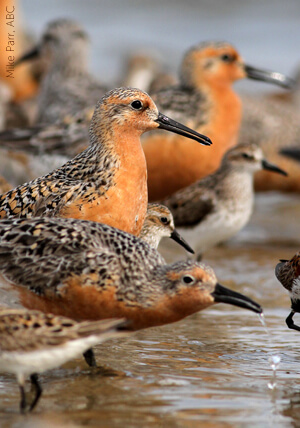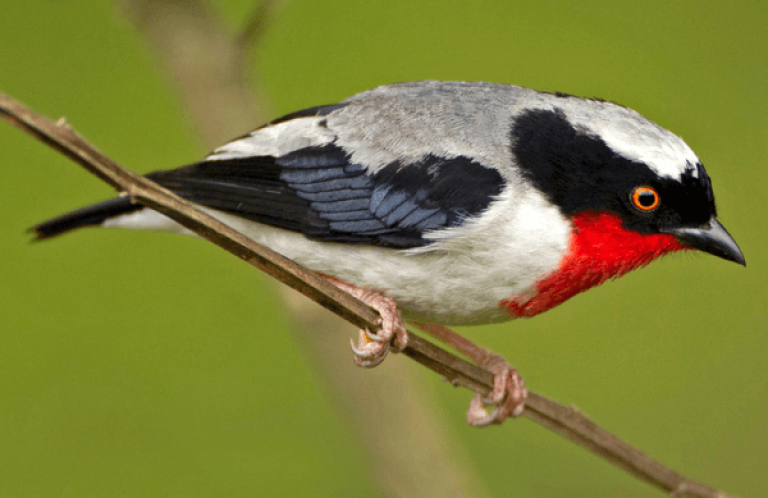Red Knot Shorebird Listed as Threatened by U.S. Fish and Wildlife Service
 |
(Washington, D.C., December 9, 2014) American Bird Conservancy (ABC), Defenders of Wildlife, and the Natural Resources Defense Council welcomed today's decision by the U.S. Fish and Wildlife Service (FWS) to formally list as threatened under the Endangered Species Act (ESA) the highly imperiled rufa Red Knot, a shorebird that flies more than 9,300 miles from south to north every spring and repeats the trip in reverse every autumn—one of the longest migrations in the animal kingdom. Though the decision to list the Red Knot was hailed as an important victory by the three groups, they urge FWS to quickly designate critical habitat to better protect the bird.
Surveys of wintering knots along the coasts of southern Chile and Argentina and in Delaware Bay on the East Coast of the United States during spring migration indicate that the species experienced a serious population decline in the 2000s. Specifically, a 2011 count of the main wintering population of the bird in South America found a decline from the previous winter of at least 5,000 birds—approximately one-third of the remaining population.
“The compelling scientific case for ESA listing fueled our 10-year effort to encourage this decision,” says Darin Schroeder, Vice President of Conservation Advocacy for ABC. “While the decision to list the rufa Red Knot was certainly a protracted process, we do now have hope that future generations of Americans will be able to witness this migratory marvel.”
Red Knot survival is tied to management practices associated with a key food source for the bird: horseshoe crab populations along the shores of New Jersey, Delaware, and Maryland. An abundant horseshoe crab population provides critical fuel for migration when the birds stop at Delaware Bay to feed on horseshoe crab eggs. Birds with higher weights have a better chance of reaching the Arctic to breed and survive into the next year.
The decline of Red Knots and other shorebird species has been largely caused by a diminishing supply of horseshoe crab eggs due to overharvesting of horseshoe crabs for bait and other purposes. When Red Knots leave Delaware Bay in poor condition due to the lack of horseshoe crab eggs, they either die before ever arriving in the Arctic or arrive in too poor a condition to successfully reproduce. As a result, adult birds are dying off without being replaced by juveniles, leading to a decline in population.
“It's clear that Red Knots are dying because we're decimating a food source they desperately need to survive,” says Jason Rylander, senior attorney at Defenders of Wildlife. “Now that they've been listed as threatened, it's time to make serious changes to horseshoe crab management and put a halt to their decline. We've waited far too long for this decision, and Red Knots are paying the price.”
Despite the growing evidence of over-exploitation of the horseshoe crab population, the Atlantic States Marine Fisheries Commission has not reduced the harvest significantly in the last six years. The State of New Jersey eventually implemented a moratorium on horseshoe crab harvesting in 2008, but Delaware and Maryland, which border Delaware Bay, have failed to do so.
“I've personally seen the Red Knot's numbers dwindling in migratory stopover points like Canada's Mingan Archipelago,” says Elly Pepper of the Natural Resources Defense Council. “These birds are strong enough to make migratory trips of nearly 20,000 miles annually, but not strong enough to weather the overharvesting of East Coast horseshoe crab populations. If we don't change management policies for one of the key foods this bird relies on quickly, one of nature's most epic journeys, and the birds that make it, will be wiped off the map.”
Red Knots are not the only species affected by the horseshoe crab fishery. Other species including Sanderlings, Ruddy Turnstones, and Semipalmated Sandpipers also depend on an abundant supply of horseshoe crab eggs at the Delaware Bay stopover and have experienced significant declines as a result of the shortage.
Background:
Since 2005, four formal requests to list the Red Knot under the Endangered Species Act have been submitted to FWS. Citing a lack of resources and other priorities, FWS chose not to list the bird but placed it on the candidate list in 2006. Since then, Red Knot numbers have continued to fall.
A “threatened species” is one that is likely to become endangered in the foreseeable future throughout all or a significant portion of its range. Such a designation requires that the species be protected from adverse effects of federal activities; provides restrictions on taking, transporting or selling a species; provides authority for recovery plans as well as the purchase of important habitat; and provides for federal aid to state and commonwealth wildlife agencies that have cooperative federal agreements.


















































